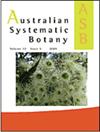Licmophora species (Bacillariophyta: Licmophorales) from Heron Island (Great Barrier Reef) and Melbourne, Australia, in comparison with similar species from Guam: evidence for endemicity in a marine diatom genus
IF 1.6
3区 生物学
Q4 EVOLUTIONARY BIOLOGY
引用次数: 2
Abstract
ABSTRACT A prevailing hypothesis of microbial biogeography holds that all species are ubiquitous, but this may lead to fitting Pacific specimens into European taxa on the basis of light microscopy. There is now evidence of regional endemicity in freshwater diatoms in Australia and recent studies have shown large diversity in the Guam marine Licmophora flora. The aim was to compare Australian samples with Guam Licmophora spp., especially their girdle bands. Valves and girdle bands from samples collected from Australia and Micronesia were described from observations made via light and scanning-electron microscopy. Of the nine species present in Australian samples, six were previously undescribed. Species with unusual characters included Licmophora insolita Lobban & Emm.S.Santos sp. nov. with a novel location for the apical rimoportula and a Tharngan strip on the valvocopula; Licmophora ballerina Lobban & S.Blanco sp. nov., with distinctive 3rd and 4th pleurae; and the licmosphenioid Licmophora johnwestii Lobban & Emm.S.Santos sp. nov. Specimens resembling Licmophora debilis (Kütz.) Grunow and L. abbreviata C.Agardh, described from Europe, occurred in Great Barrier Reef samples. The study brings the Guam flora to 20 novel v. 2 matching Atlantic–European taxa. The proportion of new to known species in Australian and Guam samples suggests regional endemicity, at least being broadly different from European Licmophora floras.与关岛的类似物种相比,Heron岛(大堡礁)和澳大利亚墨尔本的Licmophora物种(硅藻门:Licmophorales):海洋硅藻属特有性的证据
微生物生物地理学的一个主流假设认为,所有物种都是普遍存在的,但这可能导致太平洋标本在光学显微镜的基础上被纳入欧洲分类群。现在有证据表明,澳大利亚的淡水硅藻具有区域特有性,最近的研究表明,关岛海洋硅藻区系具有很大的多样性。目的是将澳大利亚的样本与关岛的Licmophora进行比较,特别是它们的腰带带。从澳大利亚和密克罗尼西亚收集的样品的阀门和腰带带通过光镜和扫描电子显微镜进行了观察。在澳大利亚样本中存在的九种中,有六种以前没有被描述过。特征不寻常的种有Licmophora solinita Lobban & emm.s.s santos sp. 11 .,其顶缘气孔位置新颖,瓣孔上有Tharngan条;Licmophora芭蕾舞演员Lobban & S.Blanco sp. nov.,具有独特的第三和第四胸膜;和licmosphenioid Licmophora johnwestii Lobban & emm.s.s santos sp. 11 . 11 .类似Licmophora debiss (k兹)的标本。来自欧洲的格鲁诺和L.缩写C.Agardh出现在大堡礁样本中。这项研究将关岛的植物群增加到20个新的、2个与大西洋-欧洲相匹配的分类群。在澳大利亚和关岛的样本中,新物种与已知物种的比例表明了区域地方性,至少与欧洲的Licmophora区系有很大的不同。
本文章由计算机程序翻译,如有差异,请以英文原文为准。
求助全文
约1分钟内获得全文
求助全文
来源期刊

Australian Systematic Botany
生物-进化生物学
CiteScore
3.10
自引率
12.50%
发文量
12
审稿时长
>12 weeks
期刊介绍:
Australian Systematic Botany is an international journal devoted to the systematics, taxonomy, and related aspects of biogeography and evolution of all algae, fungi and plants, including fossils. Descriptive taxonomic papers should normally constitute a comprehensive treatment of a group. Short papers on individual species and nomenclatural papers must contain significant new information of broader interest to be considered. The prestigious L.A.S. Johnson Review Series is published. Other review articles will also be considered. All papers are peer reviewed.
Australian Systematic Botany is published with the endorsement of the Commonwealth Scientific and Industrial Research Organisation (CSIRO) and the Australian Academy of Science.
 求助内容:
求助内容: 应助结果提醒方式:
应助结果提醒方式:


